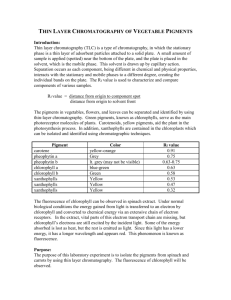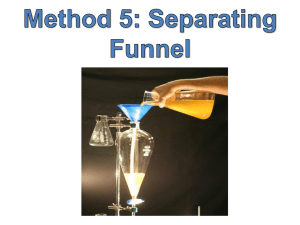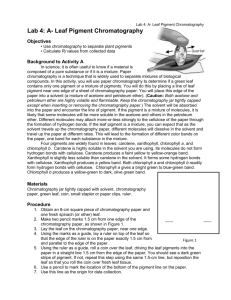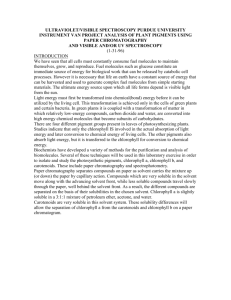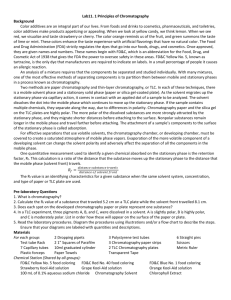13 Chromatographic analysis of chlorophyll
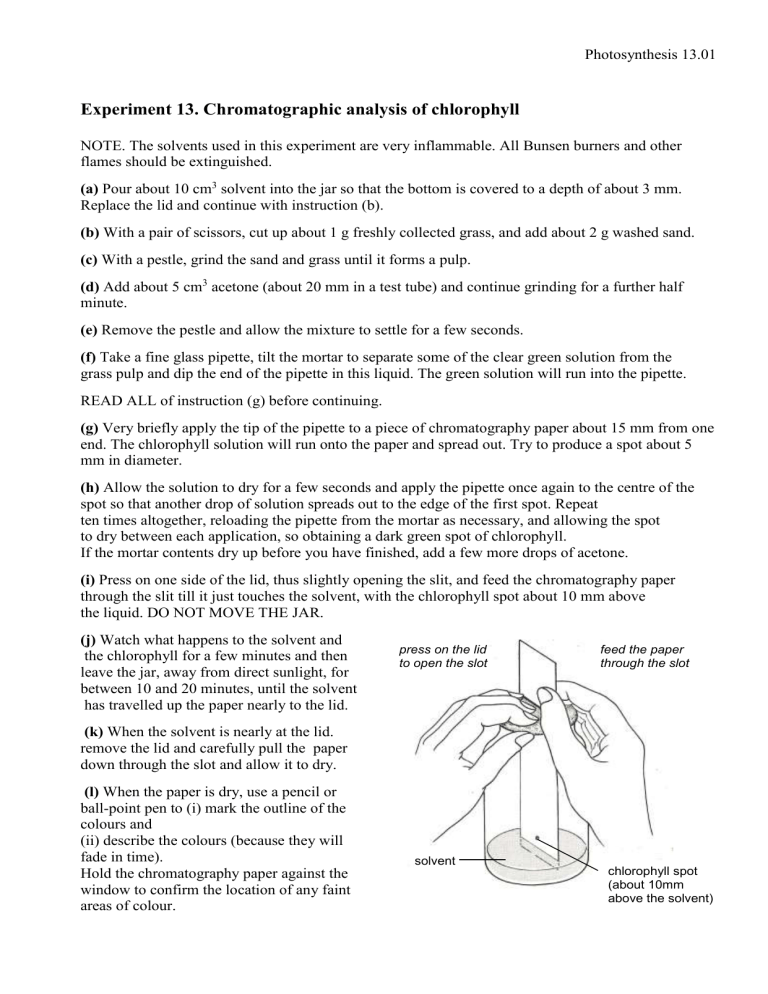
Photosynthesis 13.01
Experiment 13. Chromatographic analysis of chlorophyll
NOTE. The solvents used in this experiment are very inflammable. All Bunsen burners and other flames should be extinguished.
(a) Pour about 10 cm
3
solvent into the jar so that the bottom is covered to a depth of about 3 mm.
Replace the lid and continue with instruction (b).
(b) With a pair of scissors, cut up about 1 g freshly collected grass, and add about 2 g washed sand.
(c) With a pestle, grind the sand and grass until it forms a pulp.
(d) Add about 5 cm
3
acetone (about 20 mm in a test tube) and continue grinding for a further half minute.
(e) Remove the pestle and allow the mixture to settle for a few seconds.
(f) Take a fine glass pipette, tilt the mortar to separate some of the clear green solution from the grass pulp and dip the end of the pipette in this liquid. The green solution will run into the pipette.
READ ALL of instruction (g) before continuing.
(g) Very briefly apply the tip of the pipette to a piece of chromatography paper about 15 mm from one end. The chlorophyll solution will run onto the paper and spread out. Try to produce a spot about 5 mm in diameter.
(h) Allow the solution to dry for a few seconds and apply the pipette once again to the centre of the spot so that another drop of solution spreads out to the edge of the first spot. Repeat ten times altogether, reloading the pipette from the mortar as necessary, and allowing the spot to dry between each application, so obtaining a dark green spot of chlorophyll.
If the mortar contents dry up before you have finished, add a few more drops of acetone.
(i) Press on one side of the lid, thus slightly opening the slit, and feed the chromatography paper through the slit till it just touches the solvent, with the chlorophyll spot about 10 mm above the liquid. DO NOT MOVE THE JAR.
(j) Watch what happens to the solvent and
the chlorophyll for a few minutes and then leave the jar, away from direct sunlight, for between 10 and 20 minutes, until the solvent
has travelled up the paper nearly to the lid.
(k) When the solvent is nearly at the lid. remove the lid and carefully pull the paper down through the slot and allow it to dry.
(l) When the paper is dry, use a pencil or ball-point pen to (i) mark the outline of the colours and press on the lid to open the slot feed the paper through the slot
(ii) describe the colours (because they will fade in time).
Hold the chromatography paper against the window to confirm the location of any faint areas of colour. solvent chlorophyll spot
(about 10mm above the solvent)
Photosynthesis 13.02
Experiment 13. Chromatographic analysis of chlorophyll - preparation
Outline Grass is ground with acetone to extract the chlorophyll which is spotted on to chromatography paper and the pigments separated by ascending chromatography in a jam jar.
Prior knowledge
Meaning of 'solvent' and ‘inflammable'
Advance preparation and materials per group
Jam jar . Collect 450 gm jam jars with snap-on metal lids. With scissors or a sharp knife cut a slot in the lid without removing any metal. In this way the chromatography paper can be fed through the slot but can be gripped by the metal in any position. If the lid fails to grip the paper it can be secured with a paper clip at the required level.
If suitable jars with lids cannot be obtained, cut discs of strong card and make slots in the centre.
Fine pipette . Heat the centre of a 120 mm length of narrow glass delivery tubing in a Bunsen flame until the glass softens. Remove the tubing from the flame and pull steadily on each end to draw a fine capillary about 70-80 mm long. Break this in the middle to obtain two pipettes. Ordinary dropping pipettes are not suitable as they deliver too much liquid on to the chromatography paper.
Solvent . Petroleum ether (40-60° boiling point), 90 parts; Acetone, 10 parts. CAUTION. Very inflammable. Allow 10 cm 3 per group. washed sand, 2 g chromatography paper, e.g. Whatmans No. 1, 40 x 150 mm acetone, 5 cm 3 with more available grass, freshly collected, about 1 g
Apparatus per group jam jar with lid and slot mortar and pestle scissors fine pipette
NOTE The technique could be used (a) to separate the pigments in ‘red’ leaves (e.g. from copper beech), to show that chlorophyll was present though masked by the red colour or (b) to see how the pigments change in autumn leaves at different stages


